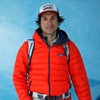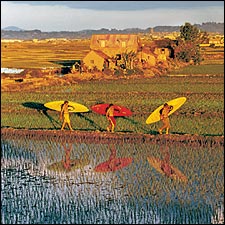A CLUSTER OF VILLAGERS has gathered at the brink of a stair-stepping, 20-foot cataract on Madagascar’s Ikopa River. Sensing the intentions of extreme kayakers Brad Ludden, 23, and his teammates—Rush Sturges, 19, and Tyler Bradt, 18—an old man wearing a blue loincloth shuffles out of the crowd. “Merci, merci,” he says in halting French. He bears no markings of rank or religion, but when he speaks, the others are silent. Chanting in his native Malagasy tongue, he reaches to the sky, gathers something invisible, and transfers it to Brad and Tyler by gesturing in an age-old ritual that looks suspiciously like jazz hands.
Madagascar's Moment
Check out exclusive online photos of monster rapids and gargantuan granite cliffs in this emerging adventure-travel hot spot. .madagascar
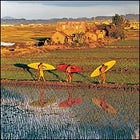 RICE AND SHINE: The crew near the capital, Antananarivo
RICE AND SHINE: The crew near the capital, Antananarivo
This is the Madagascar we were after: the one confirming rumors that the France-size avatar of biodiversity is also hiding powerful magic and some of the best whitewater the world has never seen. Thanks to our guide, Gilles Gautier, finding the Ikopa—a string of potent yet forgiving Class V rapids similar to those on the popular Zambezi River, in southern Africa—was like unearthing the Hope Diamond on the first dig. “It’s better than the Zambezi, better than New Zealand, even,” raves Ludden. The three other rivers we ran—the Lilly, the Mandraka, and the Sahatandra, with its three days’ worth of granite gorges and welcoming villages—were also rare finds.
Long a destination appealing to Darwin wannabes—as the world’s only natural habitat for lemurs and tenrecs (a kind of shrew)—this Indian Ocean island of 18 million inhabitants showed off its forbidding terrain to the world during the 1993 Raid Gauloises adventure race. Recently it’s become a magnet for other thrill seekers. The draw? Springing from the country’s mountainous north-south backbone are thousand-foot granite monoliths and waterways ranging from Sierra-style steep creeks to massive, 100-yard-wide rivers. The dense eastern jungles teem with horny chameleons, exotic birds like the blue coua, and half-dollar-size orb-web spiders, which spin robust webs across narrow rivers (prompting my arachnophobic paddling companions to execute do-or-die rolls). In the west, the dry hills and red rivers are home to 16-foot Nile crocodiles. Madagascar is notorious for red mud, but the southern winter (June through August) is dry and temperate.
With a new focus on tourism, the island’s infrastructure is slowly improving. After four decades free from French colonialism—mostly spent in sub-Haitian poverty induced by kleptocratic dictator Didier Ratsiraka—the newly elected, pro-business president, Marc Ravalomanana, is working hard to triple Madagascar’s protected lands and has signed agreements that will bring U.S. air carriers to the capital city of Antananarivo (“Tana” for short). Ecotourism is on the rise, adventure camps are springing up across the country, and a new industry of Maldives-style private-island hideaways is blossoming in the Mozambique Channel.
Despite being sucked deep below the final 20-foot drop, Ludden, Sturges, and Bradt all survived the rapid on the Ikopa they’d later christen “Heaven and Hell.” With or without a shaman’s blessing, pitching off into unknown Malagasy rivers isn’t for everyone, but there’s plenty more adventure to be had in the new Madagascar. Such as:
Rafting & Trekking
RAFTING THE MATSIATRA
Gilles Gautier is your man to float any of 13 rivers in Madagascar’s backcountry, where villages are still completely cut off from modern civilization. The premier multi-day float is on the Matsiatra, which runs south of Tana through rolling grasslands for more than 100 miles—at least half of which contain Class III whitewater—before joining the Mangoky River to reach the western coast. During the 12-day trip, your cuisine is as likely to include vampire bat as foie gras. Take note: Crocs aren’t shy. “They’ll swim right up to the raft but turn away at the last second,” says Gautier. “We’ve never had an incident.”
TREKKING THE PARKS
After taking in the palace ruins in Tana, head three hours east to the national parks around Périnet, with their nine species of lemur, including the largest, the indri. In Périnet, the Vakona Lodge offers thatched luxury and a good bottle of Bordeaux. If you want to see it all—the eroded sandstone of the Isalo Massif, humpback whales breaching in the Indian Ocean off Île Sainte Marie, and the famous stand of baobab trees in Morondava— contact John Spence at Aardvark Safaris to customize a tour.
Rock Climbing & Island Exploration
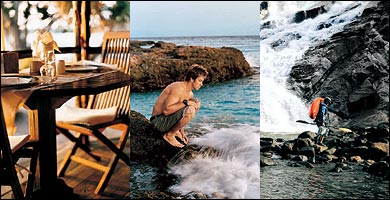
CLIMBING THE HIGHLANDS
Gautier offers guests two climbing camps: one on the island of Nosy Hara, near the northern city of Antsiranana, featuring 100-foot cliffs rising from the beach; the other, Tsarasoa, three hours south of Fianarantsoa at the base of the 2,500-foot Tsarasoa wall. It was here that Gautier brought climber Lynn Hill and her all-woman crew to pioneer a new route in 1999. For nonclimbers, mountain biking, trekking, and paragliding are the best ways to enjoy these highlands.
EXPLORING THE ISLANDS
South African expat Richard Walker’s 18-bungalow masterpiece blends into the 54-acre island of Tsarabanjina—one of a dozen in the nearly uninhabited Mitsio archipelago, an hour and a half northeast by motor launch from the resort-island hub of Nosy Be. Beaches here are connected by a tide-carved lava shelf—an ideal jumping-off point for scuba diving, fishing, sailing, and wakeboarding. Tsarabanjina provides everything you need—and nothing you don’t—for a vibe that’s part decadence, part shipwreck fantasy.
Iranja—an hour and a half by boat southwest of Nosy Be—sits on what is surely among the world’s most eye-catching landmasses: two islands connected by a mile-long ribbon of sand that submerges with the incoming tide. Twenty-nine bungalows—the largest with four wicker-furnished octagonal rooms—all overlook the ocean. On many nights, endangered hawksbill and green sea turtles crawl onto the beach to lay their eggs.
Access & Resources
madagascar
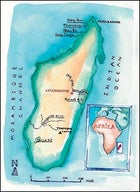
RAFT
(011-261-20-22-351-01), Gilles Gautier’s company, charges about $90 per person per day, all-inclusive, for trips on any of the 13 rivers it floats.
PARK IT
Build a 15-day custom tour, including stays in Périnet and Isalo national parks, with (011-44-1980-849160) for $4,250 per person.
CLIMB
MadaMax charges $50 per person per night at both camps—Nosy Hara and Tsarasoa— including full room and board in tents or simple bungalows.
STRAND YOURSELF
Doubles at start at $140 per night, including three meals and snorkeling. Doubles at start at $285 per night, including air conditioning and a mini-bar. Both can be booked through Aardvark Safaris.

